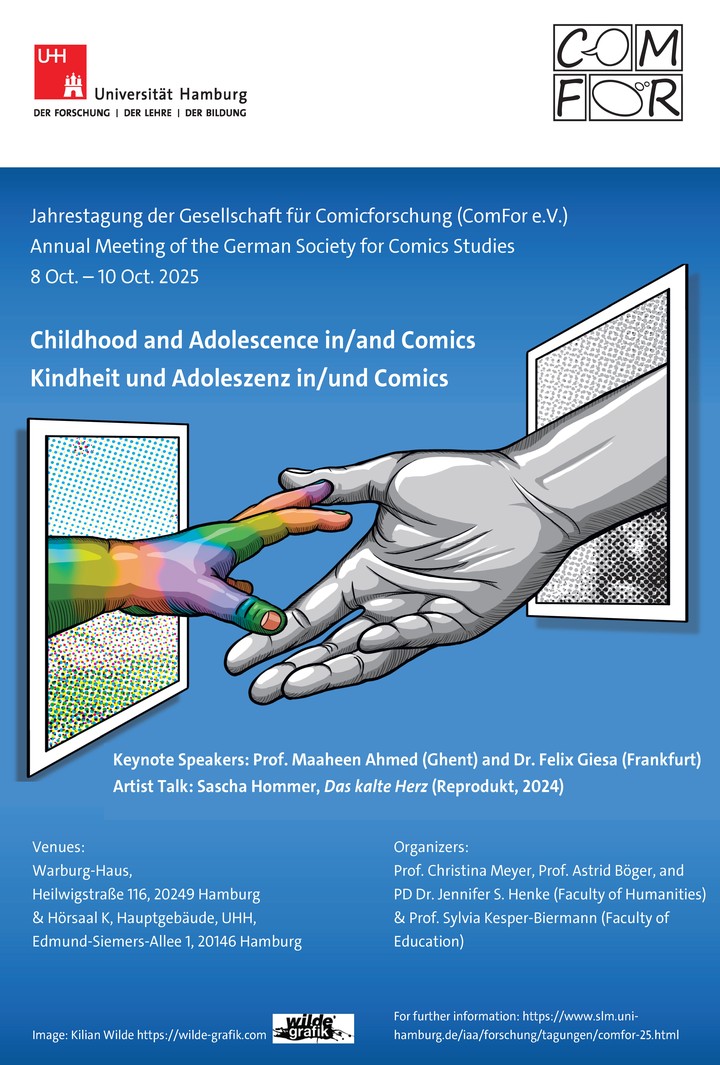Childhood and Adolescence in/and Comics

“Comics and childhood are, and long have been, inextricably linked,” writes Philip Nel (127). During this year’s annual meeting of the German Society for Comics Studies (ComFor e.V.), we want to take a closer look at and discuss together how, when and where these connections between comics and childhood as well as comics and adolescence manifest themselves and with what implications.
Such links between young readers and comics include, for instance, repeated attempts to monitor and regulate reading material for children – an example from the nineteenth century that can be mentioned here is Anthony Comstock’s (1883) Traps for the Young, a key player in the formation of the ‘degeneration of society’ discourse in the U.S. in the 1880s and 1890s, or, roughly sixty years later, the (public) debates revolving around the alleged dangers of – and manifold practices of containment targeting – mass cultural products, artefacts and phenomena that mounted their incursion into different cultures during the 1950s; in the U.S., one of the most prominent examples in this context is the Senate Judiciary Subcommittee on Juvenile Delinquency and the hearings in which different US senators (and one member of the House of Commons in Canada), psychologists (among others: Fredric Wertham), comics artists (among others: William Gaines), publishers (among others: Dell Publications) and comics distributors, drug store owners (where comics were on display) and news companies discussed whether (EC) comic books, specifically superhero and horror and crime comic books, had any negative impact on children. Similarly, in Germany, Kurt-Werner Hesse’s edited volume on Jugendgefährdung (1955) and other publications of the 1950s put the focus on the pathology of mass communication and amusement, e.g. comics. As Nel summarizes, “parallel debates over the suitability of comics for children took place around the world, prompting, or at least helping to justify, Australia’s ban on the importation of American comic books (1940-1959); Canada’s Bill 10 […], banning crime comics (1949); France’s Loi du 16 juillet sur les publications dessinées à la jeunesse […]; and Britain’s Children’s and Young Person’s (Harmful Publications) Act” (129).
The relationship between comics and childhood becomes manifest, too, in the reflections on the pedagogical value and didactic potential of comics and other forms of graphic literature in, for instance, (foreign) language teaching, art education, and political education. Early examples include special issues of different scholarly journals such as, for instance, The Journal of Educational Sociology (Dec., 1944, Vol. 18), or journals that, during the 1970s, published articles on the use(-fulness) of comics as a teaching tool (e.g. Der Deutschunterricht), or monographs such as Alfred Clemens Baumgärtner’s Die Welt der Comics (1965), to name but few.
The links between comics and children and adolescents outlined here are, obviously, just a selection of subjects we want to discuss together during this year’s annual meeting of the ComFor.
With our two confirmed keynote speakers, Prof. Dr. Maaheen Ahmed (University of Gent, Belgium) and the ComFor member Dr. Felix Giesa (Goethe-University Frankfurt, Germany), we will benefit from the expertise of two specialists in the field of children’s and adolescents’ (graphic) literature who will frame our panel discussions and award ceremonies. We are also delighted to announce that Hamburg-based artist Sascha Hommer will be joining us for a talk about his recently-published work Das Kalte Herz! We are proud to be able to hold this year’s annual meeting of the German Society for Comics Studies in the most beautiful city of Northern Germany, and look forward to inspiring discussions from October 8 to October 10, 2025.
